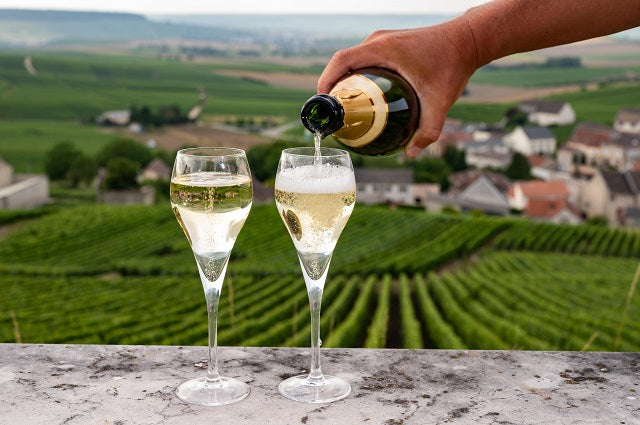The world of Champagne can be confusing, especially when it comes to sweetness levels. Terms like “Brut” and “Extra Dry” might seem straightforward, but they can be surprisingly counterintuitive.
In this guide, we’ll explain the key differences between Brut vs. Extra Dry Champagne, helping you navigate the world of bubbly with confidence.

Understanding Sweetness Levels:
Champagne sweetness is determined by the amount of residual sugar left after fermentation. Brut Champagne reigns supreme in dryness, containing a mere 0-12 grams of sugar per liter. This translates to a crisp, refreshing taste with minimal sweetness. Extra Dry Champagne, despite its name, is slightly sweeter than Brut. It boasts 12-17 grams of sugar per liter, offering a touch of sweetness that balances the acidity.
Flavor Profiles:
- Brut Champagne: Imagine a burst of zesty citrus fruits like lemon and grapefruit, followed by hints of green apple and pear. Delicate toasty and brioche notes add complexity, culminating in a clean and refreshing finish. This dry and elegant style is a crowd-pleaser for celebrations and special occasions.
- Extra Dry Champagne: While drier than sweeter Champagne styles, Extra Dry offers a touch of fruitiness. Expect notes of ripe apple, pear, and perhaps even honey or white flowers. The sweetness is well-balanced with acidity, creating a harmonious and approachable taste. This style is ideal for those who prefer a slightly sweeter sparkler.
Food Pairings:
- Brut Champagne: The dry character of Brut makes it a versatile food pairing companion. It beautifully complements seafood like oysters and enhances light appetizers such as sushi or bruschetta.
- Extra Dry Champagne: With its subtle sweetness, Extra Dry pairs well with a wider range of dishes. It complements prosciutto and melon appetizers or creamy goat cheese crostini. The acidity cuts through the richness of fried foods like calamari or tempura. Extra Dry Champagne can even handle the heat of spicy Asian cuisine, with the sweetness balancing the spice.
Popular Brands:
- Brut Champagne: Renowned houses like Moët & Chandon, Veuve Clicquot, and Dom Pérignon are known for their exceptional Brut offerings.
- Extra Dry Champagne: Laurent-Perrier, Piper-Heidsieck, and Taittinger are some well-respected producers known for crafting Extra Dry Champagnes with a touch of sweetness.
Choosing Your Perfect Champagne:

The choice between Brut and Extra Dry Champagne boils down to personal preference. Consider your taste:
- For a dry and refreshing experience, Opt for Brut Champagne.
- For a touch of sweetness and a more approachable style, Choose Extra Dry Champagne.
The Final Sip:
Understanding the difference between Brut and Extra Dry Champagne empowers you to navigate the world of sparkling wines with confidence. Whether you crave the elegance of Brut or the delicate sweetness of Extra Dry, both styles offer unique qualities to elevate your celebrations and culinary adventures. So, raise a glass and toast to explore the bubbly world of Champagne!
References:
FAQ About Brut Vs. Extra Dry: Understanding Champagne Terminology
Q: What does “Brut” mean in champagne terminology?
A: “Brut” in champagne terminology refers to a dry or very dry style of champagne, signifying very little to no added sugar in the wine.
Q: How does “Extra Dry” differ from “Brut” in terms of sweetness?
A: Despite its name, “Extra Dry” in champagne terminology actually refers to a slightly sweeter style than “Brut.” It has a touch more sweetness due to a higher level of residual sugar.
Q: Are “Brut” and “Extra Dry” the only terms used to describe champagne sweetness levels?
A: No, champagne terminology includes multiple sweetness levels. Apart from “Brut” and “Extra Dry,” there are also terms like “Sec,” “Demi-Sec,” and “Doux” that denote varying levels of sweetness in champagne.
Q: How can one determine the sweetness level of a champagne before buying it?
A: To determine the sweetness level of champagne before purchase, it is advisable to check the label where the term indicating sweetness should be displayed. This labeling convention helps consumers understand the sweetness they can expect when opening the bottle.
Q: Which sweetness level of champagne is most popular among consumers?
A: “Brut” is the most popular sweetness level of champagne among consumers, as it offers a dry and crisp taste that complements a wide range of palates and food pairings.
Q: Can personal preference influence the choice between “Brut” and “Extra Dry” champagnes?
A: Yes, personal preference plays a significant role in choosing between “Brut” and “Extra Dry” champagnes. Some individuals prefer the drier profile of “Brut,” while others may favor the slightly sweeter notes of “Extra Dry” based on their taste preferences.

Looking for a bar to make your new local hangout? Look no further than Smokin’ Cues, a hidden gem located in the heart of Stockbridge, GA. At our bar & restaurant, we’ve got you covered when it comes to a great time!
Come hear some great live music, catch some sports, have a few drinks, or just sit back and relax! At our pool hall, there’s always something to do.